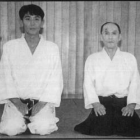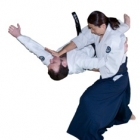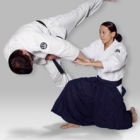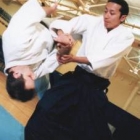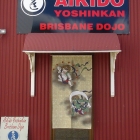As the last Uchi Deshi of the late Master Gozo Shioda, my story starts by recapturing some of the great memories I experienced at Honbu Dojo during my nine year instruction under the great man, who was considered the last of the true Japanese Budo martial artists. He was a genius, who earned his 9th dan grading from O Sensei, the founder of Aikido.
The term Uchi deshi means "live in student" who serves his Sensei at all times as part of his daily life, while continually tending to all aspects of his own life. It is the responsibility of the Uchi deshi to always work on his technique as this shows dedication to the teachings
Looking back, my Uchi deshi years at Honbu Dojo were a very hard time, occupied by strict, intense daily training commencing early in the morning until late afternoon, with many different training sessions including those with the police, riot police, and the international instructors course, along with general Honbu classes.
As Uchi deshi I was also responsible for serving the Master while ensuring I continue to practice my Yoshinkan technique and improve my level. An example of my longest day would require me to have finished my cleaning duties by 6:00am, which would include the dojo, bathrooms, shower room, change rooms, Sensei's room, etc. Then I would have nine hours of training during the day, with classes finishing at 9.00pm. After that I would train freely with the other students, perhaps for several hours, finishing at 11:30pm.
The average Uchi deshi's training day is about ten hours, including private training, six days a week, compared with the average general student's training of about two hours a day, three days a week. Effectively, one year of the Uchi deshi's training is equal to about ten years of the general student's.
Four hours of the Uchi deshi's training is occupied by a special course called "Senshusei-geiko", which is compulsory for about nine months before you can become an Uchi deshi in Yoshinkan Aikido. After that, you must continue to attend the course for about two or three years. "Senshusei" means the students who dedicate themselves to one study and "geiko" means training.
It is expected you learn everything from the basic to the advanced techniques in the first nine months. Ten selected Japanese Riot Police attend this course every year. To be selected, it is necessary you have at least a 3rd Dan in either Judo, Kendo or Karate. To quit the course halfway through would mean to quit their job as well. It is essential they take this course if they hope to receive a promotion in the future
The training in this course consists of three parts starting from basic movements. The basic movements are like "Kata" in Karate which can train the physical strength of legs and groin necessary for Aikido techniques. In the basic movements you must stand with 80 percent of your body weight rested on one leg for about five minutes moving both left and right with different movements.
The second part of the class repeats the one movement for about 40-50 minutes, continuously at the same pace. Often vomiting, breaking bones and concussions result in this part.
Straight after the technique training is basic muscle training. Starting from push-ups and sit-ups, then 500 "Koho-ukemi" (backwards breakfall) which takes about half an hour, non-stop. After that, 500 "Shuto-awase" - strike your partner's arm with yours using all your strength.
This class is usually one-and-a-half to two hours in the morning and one in the afternoon. The classes are so intense if you lose one moment's concentration, injuries are inevitable. The Uchi deshi is under further pressure from the others to be the best in the class all the time.
One of the greatest challenges as Uchi deshi is to be the Uke (one whom the master performs his technique on) of the Master, which was considered a great privilege and honour. Through the Master, you can feel the true technique, but only a senior Uchi deshi can be an Uke of the Master.
Master Gozo Shioda's teaching covered all areas of Japanese Budo through the practices of Yoshinkan Aikido, as he was intent on preserving the traditional understanding. I consider myself privileged to hear stories told by Master Shioda when he was a student of O Sensei - tales which now can only be read about in books.
Due to the culture and rules of Honbu dojo there are certain requirements you must fulfil as Uchi deshi - failing to achieve these objectives would mean instant dismissal.
Shioda Sensei's room was next to mine and as the Uchi deshi I would always have to be sensitive of what he was doing next door. I would listen for Shioda Sensei's movements and when Sensei wanted to go to the bathroom, rush in and open the door for him. Irrespective of what I was doing, I had to be aware of what Shioda Sensei was doing. After my first year of Uchi deshi, I got very sick from nerves as every door sounded like Shioda Sensei's.
For example, as an Uchi deshi, I had to know when Master was drinking tea and be able to tell the difference from when he was placing the cup down and resting from the drink, to when the cup was placed on the table after he had finished the drink, then rush in and quickly fill his cup again. When he was eating his meal I had to listen for when he was finished, then quickly get the tray back
Japanese bathrooms are usually different from those found in Australia. In Japan, the bathroom has two sections, the first for undressing and dressing and an inner room where you wash your body outside the bath so when you enter the bath you are clean and do not dirty the water.
In the bathroom, when Master wanted to take a bath I would have to go with him, open the door, ask him to please enter, excuse myself that I was also entering the room and always have the right timing. When he wanted assistance, I would help him, but not touch him when he didn't. When he was undressing, I had to assist in taking off his clothes off, fold the clothes quickly and then attend to his next need. When he needed soap or water, I had to give it to him before he moved, make sure he was warm and quickly go back to his room, get his clothes and then run back again. I had to be totally in tune with Master in every sense as an Uchi deshi. Once Master was ready for his next engagement, I had to quickly get ready for my next class, ensuring that while assisting Shioda Sensei, I didn't neglect my other responsibilities.
As Uchi deshi, I also had to sense his intention, when I could sense his every mood and feeling I could then be his Uke. To learn his real technique meant I had to understand him as a whole, his private life and Yoshinkan life. We would walk together and when Master looked at a general student and nodded, I had to understand what he meant. I also had to know which student Master was referring to so I could correct that student's technique. If I did not correct what Master expected, I would receive a serious scolding.
When I decided I wanted to do Yoshinkan Aikido, I was 18 and Master Shioda was in his 60's. To me, Master was a small old man and I couldn't understand how someone that old and small could be as great as people said. When I first started learning, Takeno Sensei was the head instructor, he was young, strong, sharp and scary and at the time I thought he was better than the Master.
This perception changed after the first time I attended a special class for black belts only. I was amazed to see Shioda Sensei effortlessly throw Takeno Sensei to the mats time and time again. It was then I could understand how effective Master Shioda Sensei's technique was.
Takeno Sensei's technique felt very strong and sharp, but Master Shioda Sensei executed his technique so swiftly I hardly felt anything but one movement, then all the muscles in my body were locked instantly. It felt like a vibration went through the whole body, which was being controlled by this little old man, though I didn't feel any pain. The weight he applied before he threw was so intense it felt like I had weights dropped on me a second before my whole body collapsed.
Shortly before Master Shioda Sensei passed away he attended the annual demonstration of Yoshinkan Aikido Honbu Dojo, even though he was so sick he needed someone to help him walk. After everyone had finished he stepped onto the mats to give a speech, but as he spoke his body started to move, as he began to demonstrate two techniques. The whole dojo went silent when they saw the Master moving, a man almost on his death-bed still so in tune with his body and Yoshinkan Aikido, that although he struggled to walk, he effortlessly demonstrated his techniques. This was to be his very last demonstration.
There are many great memories of Master Shioda Sensei, with the respect he earned from around the world. For me, the strength and power of his teaching he displayed during his public demonstration is something I will always treasure as I was honoured to be his last Uke.
I was assigned missions such as instructing the Tokyo riot police, along with other programs at Honbu dojo such as daily international instructor's courses, trips overseas to train military and police forces in countries such as Canada, USA, India, Malta and of course here in Australia. When I was sent to instruct in other countries, I not only trained the police and military, but I instructed general classes at the various dojos as well. My dojo here in Brisbane continues ties with the police force.
I came to Australia through the assistance of Joe Thambu Sensei in Melbourne, who I met in Japan at Honbu dojo. Through his assistance, I could open my own dojo here in Australia.
I opened my dojo "Aikido Yoshinkan Brisbane Dojo" in July 1995 with succeeding the Japanese Budo tradition and culture in mind, and of course to honour Master Shioda's spirit. Since the day I opened my dojo, I devoted myself in teaching this art to Australians and as I did so, my knowledge in the art got deepened. Many Australian students were strong-built and I had to amend and improve my techniques to convince them with the power of Aiki. I developed my own style to suit the need of skills in this modern age and now it is called 'Goshu-ryu Aiki Jujutsu.' The techniques of Goshu-ryu Aiki Jujutsu are useful in the real world which are quick and powerful. I am proud of my dojo and its students for they can contribute positively to a better community and more harmonious society.
Michiharu Mori

